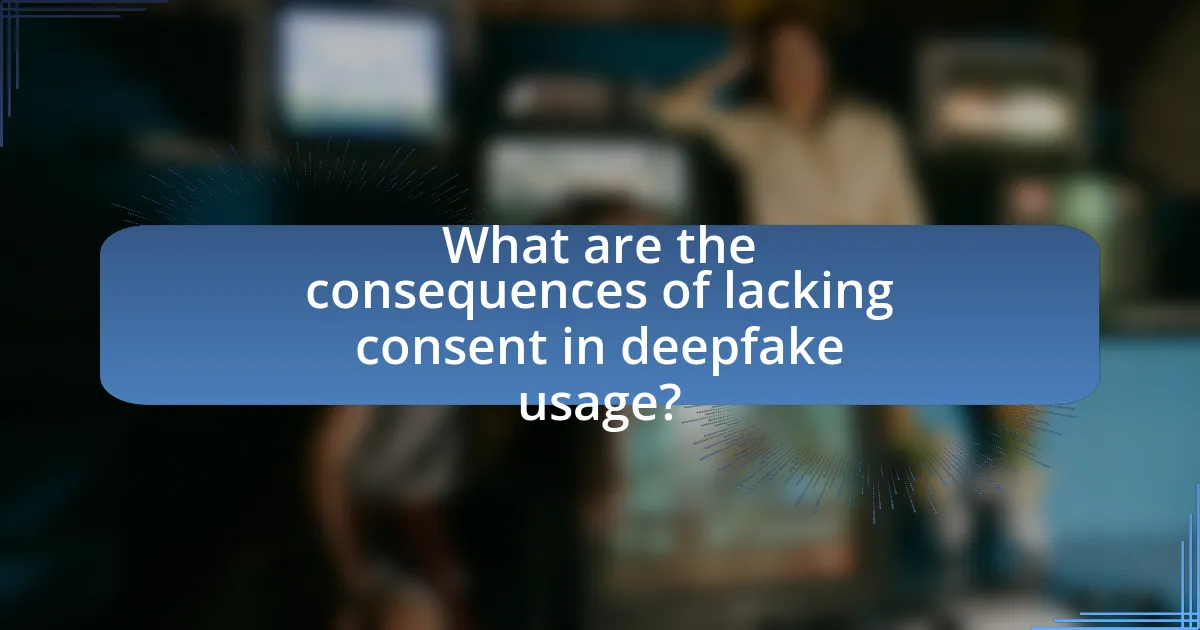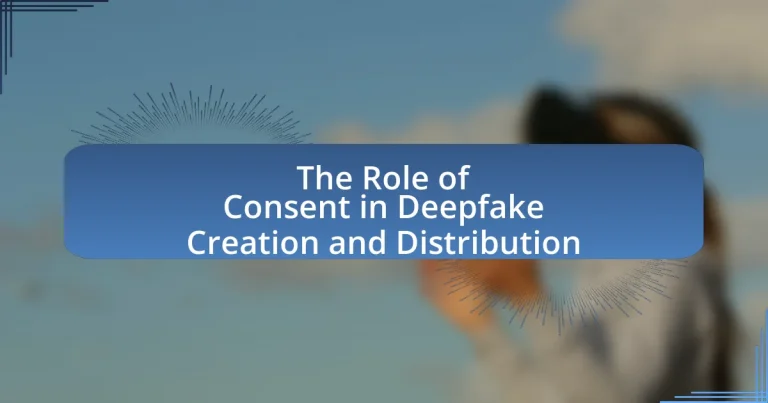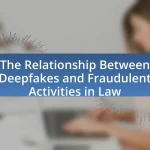The article focuses on the critical role of consent in the creation and distribution of deepfakes, emphasizing its legal and ethical implications. It outlines how consent protects individuals’ rights and autonomy over their likeness, preventing potential harm such as reputational damage and emotional distress. The article also discusses the legal frameworks that necessitate consent, the methods for obtaining it, and the challenges posed by technological advancements. Additionally, it highlights the consequences of lacking consent, including legal repercussions and psychological impacts on victims, while providing guidance on best practices for creators to ensure ethical deepfake production.

What is the Role of Consent in Deepfake Creation and Distribution?
Consent is crucial in deepfake creation and distribution as it determines the legality and ethical implications of using an individual’s likeness. Without consent, the creation and sharing of deepfakes can lead to violations of privacy rights and potential harm to the individual’s reputation. Legal frameworks, such as the California Consumer Privacy Act, emphasize the necessity of obtaining consent to avoid legal repercussions. Furthermore, studies indicate that unauthorized deepfakes can result in psychological distress for the subjects involved, highlighting the importance of consent in protecting individuals from exploitation and misuse of their images.
Why is consent important in the context of deepfakes?
Consent is crucial in the context of deepfakes because it protects individuals’ rights and autonomy over their likeness and personal data. Without consent, the creation and distribution of deepfakes can lead to significant harm, including reputational damage, emotional distress, and potential legal consequences. For instance, a study by the University of California, Berkeley, highlights that unauthorized use of someone’s image in deepfakes can result in identity theft and harassment, emphasizing the need for explicit permission to use an individual’s likeness. Thus, consent serves as a fundamental ethical and legal safeguard against the misuse of technology in deepfake creation and distribution.
How does consent impact the ethical considerations of deepfake technology?
Consent is crucial in shaping the ethical considerations of deepfake technology, as it determines the legitimacy of using an individual’s likeness or voice in synthetic media. When consent is obtained, the ethical implications are significantly mitigated, allowing for creative expression and innovation while respecting personal autonomy. Conversely, the absence of consent raises serious ethical concerns, including potential harm, exploitation, and violation of privacy rights. For instance, unauthorized deepfakes can lead to reputational damage, emotional distress, and even legal repercussions for the individuals depicted. Thus, consent serves as a foundational element in evaluating the morality of deepfake creation and distribution, ensuring that individuals retain control over their personal representations.
What are the legal implications of consent in deepfake creation?
The legal implications of consent in deepfake creation primarily revolve around issues of privacy, intellectual property, and potential defamation. When an individual’s likeness is used in a deepfake without their consent, it can lead to violations of privacy rights, as established in various jurisdictions that protect individuals from unauthorized use of their image. For instance, in the United States, the right of publicity allows individuals to control the commercial use of their identity, which can be infringed upon by deepfake technology. Additionally, deepfakes can result in defamation claims if the manipulated content misrepresents the individual in a harmful way. Courts have increasingly recognized the need for consent in these contexts, as seen in cases where unauthorized use of a person’s likeness has led to legal action. Thus, consent is crucial in mitigating legal risks associated with deepfake creation and distribution.
How is consent obtained for deepfake creation?
Consent for deepfake creation is typically obtained through explicit agreements between the creator and the individual whose likeness is being used. This process often involves obtaining written permission that outlines the intended use of the deepfake, ensuring that the individual is fully informed about how their image or voice will be manipulated and distributed. Legal frameworks, such as privacy laws and intellectual property rights, further reinforce the necessity of obtaining consent, as unauthorized use can lead to legal repercussions. For instance, in jurisdictions like California, the California Consumer Privacy Act mandates that individuals have control over their personal data, which includes their likeness in digital content.
What methods are used to secure consent from individuals featured in deepfakes?
Methods used to secure consent from individuals featured in deepfakes include obtaining explicit written agreements, utilizing digital consent forms, and implementing blockchain technology for verification. Explicit written agreements ensure that individuals are fully aware of how their likeness will be used, while digital consent forms streamline the process and provide a record of consent. Blockchain technology can enhance transparency and security by creating an immutable record of consent transactions, thereby protecting the rights of individuals. These methods are essential in addressing ethical concerns and legal implications surrounding deepfake technology.
How does the clarity of consent affect the use of deepfakes?
The clarity of consent significantly impacts the ethical and legal use of deepfakes. Clear consent ensures that individuals are fully aware of how their likenesses will be used, which can prevent misuse and exploitation. For instance, when consent is ambiguous or not explicitly obtained, creators may face legal repercussions, as seen in cases where individuals have sued for unauthorized use of their images in deepfake pornography. This highlights the necessity for transparent consent processes to protect individuals’ rights and maintain ethical standards in deepfake technology.
What challenges exist in ensuring consent for deepfake distribution?
Ensuring consent for deepfake distribution faces significant challenges, primarily due to the difficulty in verifying the identity of individuals depicted in deepfakes. The technology allows for the creation of highly realistic videos that can manipulate appearances and voices, making it challenging to ascertain whether the person in the deepfake has genuinely consented to its creation or distribution. Additionally, legal frameworks surrounding consent are often outdated and do not adequately address the complexities introduced by deepfake technology, leading to ambiguity in rights and responsibilities. For instance, a study by the University of California, Berkeley, highlights that existing laws may not sufficiently protect individuals from unauthorized use of their likeness in deepfakes, further complicating consent issues.
How do technological advancements complicate the consent process?
Technological advancements complicate the consent process by enabling the creation and distribution of deepfakes, which can manipulate images and videos without the original subject’s knowledge or approval. The rise of sophisticated algorithms and artificial intelligence allows for realistic alterations that can mislead viewers and create false narratives, making it difficult for individuals to maintain control over their likeness. For instance, a study published in the journal “Nature” highlights that deepfake technology can produce highly convincing fake videos, raising ethical concerns about consent and authenticity. This technological capability challenges traditional consent frameworks, as individuals may find their identities misappropriated without any legal recourse or awareness.
What role do platforms play in enforcing consent for deepfake content?
Platforms play a crucial role in enforcing consent for deepfake content by implementing policies and technologies that regulate the creation and distribution of such material. These platforms often establish community guidelines that prohibit the use of deepfakes without explicit consent from the individuals depicted, thereby aiming to protect users from potential harm and misuse. For instance, major platforms like Facebook and YouTube have developed specific policies that address deepfake content, requiring users to verify consent before sharing or creating such media. This regulatory approach is supported by legal frameworks in various jurisdictions that hold platforms accountable for the content they host, reinforcing the necessity for consent.

What are the consequences of lacking consent in deepfake usage?
Lacking consent in deepfake usage can lead to severe legal, ethical, and social consequences. Legally, individuals can face criminal charges for defamation, harassment, or privacy violations, as unauthorized use of someone’s likeness can infringe on their rights. Ethically, the creation and distribution of deepfakes without consent undermine trust and can cause significant emotional distress to the individuals depicted. Socially, the proliferation of non-consensual deepfakes can contribute to misinformation, damage reputations, and erode public confidence in media authenticity. For instance, a study by the University of California, Berkeley, highlights that 96% of deepfake videos are pornographic and often involve non-consensual imagery, illustrating the potential for harm and exploitation.
What are the potential harms caused by non-consensual deepfakes?
Non-consensual deepfakes can cause significant harm by violating individuals’ privacy and dignity. These manipulated videos or images can lead to reputational damage, emotional distress, and harassment, as they often depict individuals in compromising or false scenarios without their consent. Research indicates that victims of non-consensual deepfakes experience increased anxiety and fear for their safety, with studies showing that 96% of victims reported negative emotional impacts. Furthermore, non-consensual deepfakes can facilitate misinformation and manipulation, undermining trust in media and contributing to broader societal issues such as cyberbullying and defamation.
How can non-consensual deepfakes affect individuals’ reputations?
Non-consensual deepfakes can severely damage individuals’ reputations by misrepresenting their actions or statements, leading to public humiliation and loss of trust. These manipulated videos or images can spread rapidly on social media, creating false narratives that can be difficult to counteract. Research indicates that 96% of deepfake content is pornographic, often targeting women, which can result in significant emotional distress and professional repercussions for the victims. Furthermore, a study published in the journal “Cyberpsychology, Behavior, and Social Networking” found that individuals exposed to deepfakes are more likely to believe the misinformation presented, further entrenching the reputational harm.
What psychological impacts can arise from the misuse of deepfakes?
The misuse of deepfakes can lead to significant psychological impacts, including anxiety, depression, and a loss of trust in media. Victims of deepfake technology may experience emotional distress due to the manipulation of their likeness, which can result in feelings of violation and helplessness. Research indicates that individuals targeted by malicious deepfakes often suffer from increased paranoia and social withdrawal, as they may fear further exploitation or damage to their reputation. A study published in the journal “Cyberpsychology, Behavior, and Social Networking” highlights that victims report a decline in mental well-being and heightened stress levels, demonstrating the profound psychological effects of such digital manipulations.
What legal actions can be taken against non-consensual deepfake creators?
Legal actions against non-consensual deepfake creators include civil lawsuits for defamation, invasion of privacy, and emotional distress, as well as potential criminal charges under laws targeting harassment or identity theft. For instance, some jurisdictions have enacted specific legislation addressing deepfakes, such as California’s AB 730, which makes it illegal to use deepfakes to harm or defraud individuals without their consent. These legal frameworks provide victims with avenues to seek redress and hold creators accountable for the unauthorized use of their likenesses.
What laws currently exist to protect individuals from non-consensual deepfakes?
Currently, several laws exist to protect individuals from non-consensual deepfakes, including state-level legislation and federal laws addressing privacy and harassment. For instance, California’s AB 730 specifically targets the creation and distribution of non-consensual deepfake pornography, making it illegal to use deepfake technology to create sexually explicit content without consent. Additionally, the Malicious Deep Fake Prohibition Act, introduced at the federal level, aims to criminalize the use of deepfakes for malicious purposes, including harassment and defamation. These laws reflect a growing recognition of the potential harm caused by non-consensual deepfakes and provide legal recourse for affected individuals.
How effective are current legal frameworks in addressing deepfake issues?
Current legal frameworks are largely ineffective in addressing deepfake issues due to gaps in existing laws and the rapid evolution of technology. For instance, many jurisdictions lack specific legislation targeting deepfakes, relying instead on outdated laws related to defamation, copyright, or privacy that do not adequately cover the unique challenges posed by deepfake technology. A report by the Brookings Institution highlights that only a few states in the U.S. have enacted laws specifically addressing deepfakes, indicating a significant legislative lag. Furthermore, the decentralized nature of the internet complicates enforcement, as deepfakes can easily be disseminated across borders, making it difficult for any single legal framework to be effective.

How can individuals protect their consent rights in the age of deepfakes?
Individuals can protect their consent rights in the age of deepfakes by actively monitoring their digital presence and utilizing privacy settings on social media platforms. By regularly reviewing and adjusting privacy settings, individuals can limit the accessibility of their images and videos, thereby reducing the risk of unauthorized deepfake creation. Additionally, individuals should educate themselves about deepfake technology and its implications, enabling them to recognize potential threats and take proactive measures. Legal frameworks, such as copyright and privacy laws, can also be leveraged to assert rights against unauthorized use of one’s likeness. For instance, in some jurisdictions, individuals can pursue legal action if their likeness is used without consent, reinforcing their control over personal images.
What steps can individuals take to safeguard their image and likeness?
Individuals can safeguard their image and likeness by actively managing their online presence and utilizing legal protections. They should regularly monitor their digital footprint, ensuring that personal images and videos are shared only on trusted platforms with appropriate privacy settings. Additionally, individuals can employ watermarking techniques on images to deter unauthorized use and consider using legal agreements that specify how their likeness can be used. Legal frameworks, such as the right of publicity, provide individuals with the ability to control commercial use of their image and likeness, reinforcing their rights against unauthorized exploitation.
How can individuals educate themselves about their rights regarding deepfakes?
Individuals can educate themselves about their rights regarding deepfakes by researching relevant laws and regulations that govern digital content and consent. Many jurisdictions have enacted laws addressing the creation and distribution of deepfakes, particularly in relation to privacy and defamation. For instance, California’s AB 730 law specifically targets the malicious use of deepfakes in contexts like elections and pornography, providing a legal framework for individuals to understand their rights. Additionally, organizations such as the Electronic Frontier Foundation offer resources and guides that explain the implications of deepfakes and individuals’ rights in various contexts. Engaging with these resources enables individuals to stay informed about their legal protections and the ethical considerations surrounding deepfake technology.
What resources are available for reporting non-consensual deepfake content?
To report non-consensual deepfake content, individuals can utilize various resources such as online reporting tools provided by social media platforms, legal assistance from organizations specializing in digital rights, and law enforcement agencies. Major platforms like Facebook, Twitter, and YouTube have specific reporting mechanisms for deepfake content that violates their policies. Additionally, organizations like the Cyber Civil Rights Initiative offer guidance and support for victims, while local law enforcement can assist in addressing potential legal violations. These resources are essential for addressing the misuse of deepfake technology and protecting individuals’ rights.
What best practices should creators follow to ensure ethical deepfake production?
Creators should prioritize obtaining explicit consent from individuals whose likenesses are used in deepfake production. This practice ensures respect for personal rights and autonomy, as highlighted by legal frameworks such as the General Data Protection Regulation (GDPR), which emphasizes the importance of consent in data usage. Additionally, creators should provide clear disclosures about the nature and purpose of the deepfake, fostering transparency and accountability. Research indicates that ethical guidelines, like those proposed by the Partnership on AI, advocate for responsible use of AI technologies, including deepfakes, to prevent misinformation and harm. By adhering to these best practices, creators can contribute to a more ethical landscape in deepfake technology.
How can creators implement transparent consent processes?
Creators can implement transparent consent processes by clearly outlining the terms of use and obtaining explicit permission from individuals whose likenesses or voices are used in deepfake content. This can be achieved through written agreements that specify how the content will be used, the duration of consent, and the rights of the individuals involved. Research indicates that clear communication and documentation of consent not only protect the rights of individuals but also enhance trust between creators and their subjects, as seen in studies on ethical media practices.
What guidelines should be established for responsible deepfake distribution?
Responsible deepfake distribution guidelines should prioritize informed consent, transparency, and ethical use. Informed consent requires that individuals depicted in deepfakes explicitly agree to their likeness being used, ensuring they understand the context and potential implications. Transparency involves clearly labeling deepfakes to distinguish them from authentic content, which helps prevent misinformation and deception. Ethical use mandates that deepfakes should not be employed for malicious purposes, such as harassment or defamation, aligning with legal standards and societal norms. These guidelines are supported by the increasing recognition of the potential harms associated with deepfakes, as highlighted in studies that show their capacity to mislead and manipulate public perception.


